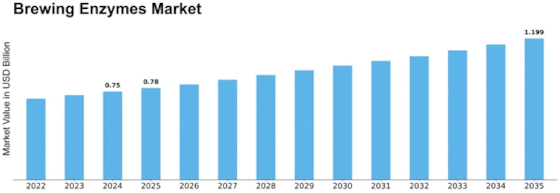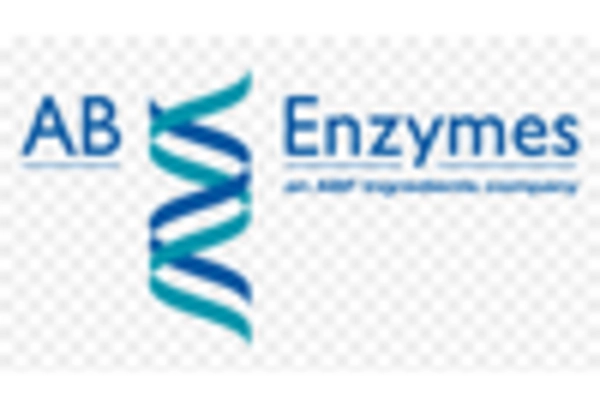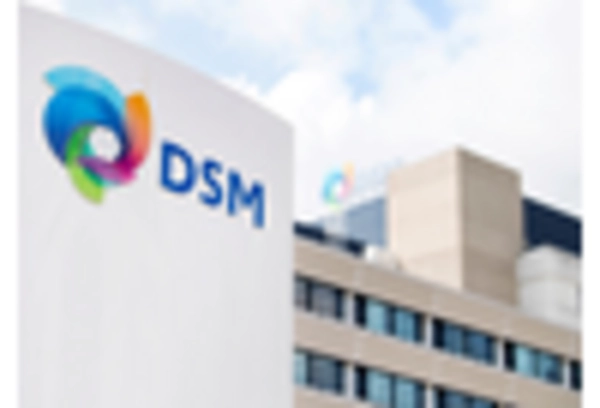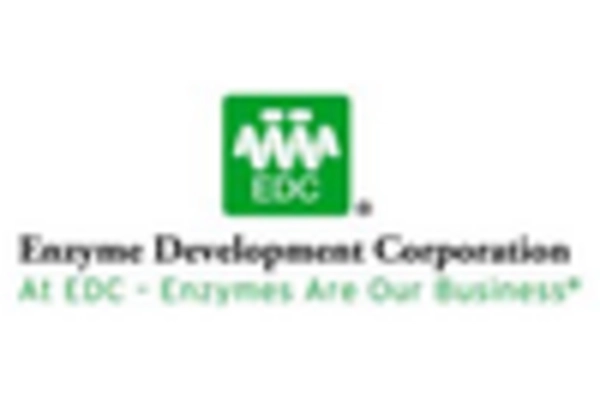Beer Production
Wort Production
Fermentation Process
Clarification
Amylase
Protease
Cellulase
Lactase
Pectinase
Liquid
Powder
Granular
Craft Breweries
Commercial Breweries
Home Brewing
North America
Europe
South America
Asia Pacific
Middle East and Africa
North America Outlook (USD Billion, 2019-2035)
North America Brewing Enzymes Market by Application Type
Beer Production
Wort Production
Fermentation Process
Clarification
North America Brewing Enzymes Market by Type
Amylase
Protease
Cellulase
Lactase
Pectinase
North America Brewing Enzymes Market by Formulation Type
Liquid
Powder
Granular
North America Brewing Enzymes Market by End Use Type
Craft Breweries
Commercial Breweries
Home Brewing
North America Brewing Enzymes Market by Regional Type
US
Canada
US Outlook (USD Billion, 2019-2035)
US Brewing Enzymes Market by Application Type
Beer Production
Wort Production
Fermentation Process
Clarification
US Brewing Enzymes Market by Type
Amylase
Protease
Cellulase
Lactase
Pectinase
US Brewing Enzymes Market by Formulation Type
Liquid
Powder
Granular
US Brewing Enzymes Market by End Use Type
Craft Breweries
Commercial Breweries
Home Brewing
CANADA Outlook (USD Billion, 2019-2035)
CANADA Brewing Enzymes Market by Application Type
Beer Production
Wort Production
Fermentation Process
Clarification
CANADA Brewing Enzymes Market by Type
Amylase
Protease
Cellulase
Lactase
Pectinase
CANADA Brewing Enzymes Market by Formulation Type
Liquid
Powder
Granular
CANADA Brewing Enzymes Market by End Use Type
Craft Breweries
Commercial Breweries
Home Brewing
Europe Outlook (USD Billion, 2019-2035)
Europe Brewing Enzymes Market by Application Type
Beer Production
Wort Production
Fermentation Process
Clarification
Europe Brewing Enzymes Market by Type
Amylase
Protease
Cellulase
Lactase
Pectinase
Europe Brewing Enzymes Market by Formulation Type
Liquid
Powder
Granular
Europe Brewing Enzymes Market by End Use Type
Craft Breweries
Commercial Breweries
Home Brewing
Europe Brewing Enzymes Market by Regional Type
Germany
UK
France
Russia
Italy
Spain
Rest of Europe
GERMANY Outlook (USD Billion, 2019-2035)
GERMANY Brewing Enzymes Market by Application Type
Beer Production
Wort Production
Fermentation Process
Clarification
GERMANY Brewing Enzymes Market by Type
Amylase
Protease
Cellulase
Lactase
Pectinase
GERMANY Brewing Enzymes Market by Formulation Type
Liquid
Powder
Granular
GERMANY Brewing Enzymes Market by End Use Type
Craft Breweries
Commercial Breweries
Home Brewing
UK Outlook (USD Billion, 2019-2035)
UK Brewing Enzymes Market by Application Type
Beer Production
Wort Production
Fermentation Process
Clarification
UK Brewing Enzymes Market by Type
Amylase
Protease
Cellulase
Lactase
Pectinase
UK Brewing Enzymes Market by Formulation Type
Liquid
Powder
Granular
UK Brewing Enzymes Market by End Use Type
Craft Breweries
Commercial Breweries
Home Brewing
FRANCE Outlook (USD Billion, 2019-2035)
FRANCE Brewing Enzymes Market by Application Type
Beer Production
Wort Production
Fermentation Process
Clarification
FRANCE Brewing Enzymes Market by Type
Amylase
Protease
Cellulase
Lactase
Pectinase
FRANCE Brewing Enzymes Market by Formulation Type
Liquid
Powder
Granular
FRANCE Brewing Enzymes Market by End Use Type
Craft Breweries
Commercial Breweries
Home Brewing
RUSSIA Outlook (USD Billion, 2019-2035)
RUSSIA Brewing Enzymes Market by Application Type
Beer Production
Wort Production
Fermentation Process
Clarification
RUSSIA Brewing Enzymes Market by Type
Amylase
Protease
Cellulase
Lactase
Pectinase
RUSSIA Brewing Enzymes Market by Formulation Type
Liquid
Powder
Granular
RUSSIA Brewing Enzymes Market by End Use Type
Craft Breweries
Commercial Breweries
Home Brewing
ITALY Outlook (USD Billion, 2019-2035)
ITALY Brewing Enzymes Market by Application Type
Beer Production
Wort Production
Fermentation Process
Clarification
ITALY Brewing Enzymes Market by Type
Amylase
Protease
Cellulase
Lactase
Pectinase
ITALY Brewing Enzymes Market by Formulation Type
Liquid
Powder
Granular
ITALY Brewing Enzymes Market by End Use Type
Craft Breweries
Commercial Breweries
Home Brewing
SPAIN Outlook (USD Billion, 2019-2035)
SPAIN Brewing Enzymes Market by Application Type
Beer Production
Wort Production
Fermentation Process
Clarification
SPAIN Brewing Enzymes Market by Type
Amylase
Protease
Cellulase
Lactase
Pectinase
SPAIN Brewing Enzymes Market by Formulation Type
Liquid
Powder
Granular
SPAIN Brewing Enzymes Market by End Use Type
Craft Breweries
Commercial Breweries
Home Brewing
REST OF EUROPE Outlook (USD Billion, 2019-2035)
REST OF EUROPE Brewing Enzymes Market by Application Type
Beer Production
Wort Production
Fermentation Process
Clarification
REST OF EUROPE Brewing Enzymes Market by Type
Amylase
Protease
Cellulase
Lactase
Pectinase
REST OF EUROPE Brewing Enzymes Market by Formulation Type
Liquid
Powder
Granular
REST OF EUROPE Brewing Enzymes Market by End Use Type
Craft Breweries
Commercial Breweries
Home Brewing
APAC Outlook (USD Billion, 2019-2035)
APAC Brewing Enzymes Market by Application Type
Beer Production
Wort Production
Fermentation Process
Clarification
APAC Brewing Enzymes Market by Type
Amylase
Protease
Cellulase
Lactase
Pectinase
APAC Brewing Enzymes Market by Formulation Type
Liquid
Powder
Granular
APAC Brewing Enzymes Market by End Use Type
Craft Breweries
Commercial Breweries
Home Brewing
APAC Brewing Enzymes Market by Regional Type
China
India
Japan
South Korea
Malaysia
Thailand
Indonesia
Rest of APAC
CHINA Outlook (USD Billion, 2019-2035)
CHINA Brewing Enzymes Market by Application Type
Beer Production
Wort Production
Fermentation Process
Clarification
CHINA Brewing Enzymes Market by Type
Amylase
Protease
Cellulase
Lactase
Pectinase
CHINA Brewing Enzymes Market by Formulation Type
Liquid
Powder
Granular
CHINA Brewing Enzymes Market by End Use Type
Craft Breweries
Commercial Breweries
Home Brewing
INDIA Outlook (USD Billion, 2019-2035)
INDIA Brewing Enzymes Market by Application Type
Beer Production
Wort Production
Fermentation Process
Clarification
INDIA Brewing Enzymes Market by Type
Amylase
Protease
Cellulase
Lactase
Pectinase
INDIA Brewing Enzymes Market by Formulation Type
Liquid
Powder
Granular
INDIA Brewing Enzymes Market by End Use Type
Craft Breweries
Commercial Breweries
Home Brewing
JAPAN Outlook (USD Billion, 2019-2035)
JAPAN Brewing Enzymes Market by Application Type
Beer Production
Wort Production
Fermentation Process
Clarification
JAPAN Brewing Enzymes Market by Type
Amylase
Protease
Cellulase
Lactase
Pectinase
JAPAN Brewing Enzymes Market by Formulation Type
Liquid
Powder
Granular
JAPAN Brewing Enzymes Market by End Use Type
Craft Breweries
Commercial Breweries
Home Brewing
SOUTH KOREA Outlook (USD Billion, 2019-2035)
SOUTH KOREA Brewing Enzymes Market by Application Type
Beer Production
Wort Production
Fermentation Process
Clarification
SOUTH KOREA Brewing Enzymes Market by Type
Amylase
Protease
Cellulase
Lactase
Pectinase
SOUTH KOREA Brewing Enzymes Market by Formulation Type
Liquid
Powder
Granular
SOUTH KOREA Brewing Enzymes Market by End Use Type
Craft Breweries
Commercial Breweries
Home Brewing
MALAYSIA Outlook (USD Billion, 2019-2035)
MALAYSIA Brewing Enzymes Market by Application Type
Beer Production
Wort Production
Fermentation Process
Clarification
MALAYSIA Brewing Enzymes Market by Type
Amylase
Protease
Cellulase
Lactase
Pectinase
MALAYSIA Brewing Enzymes Market by Formulation Type
Liquid
Powder
Granular
MALAYSIA Brewing Enzymes Market by End Use Type
Craft Breweries
Commercial Breweries
Home Brewing
THAILAND Outlook (USD Billion, 2019-2035)
THAILAND Brewing Enzymes Market by Application Type
Beer Production
Wort Production
Fermentation Process
Clarification
THAILAND Brewing Enzymes Market by Type
Amylase
Protease
Cellulase
Lactase
Pectinase
THAILAND Brewing Enzymes Market by Formulation Type
Liquid
Powder
Granular
THAILAND Brewing Enzymes Market by End Use Type
Craft Breweries
Commercial Breweries
Home Brewing
INDONESIA Outlook (USD Billion, 2019-2035)
INDONESIA Brewing Enzymes Market by Application Type
Beer Production
Wort Production
Fermentation Process
Clarification
INDONESIA Brewing Enzymes Market by Type
Amylase
Protease
Cellulase
Lactase
Pectinase
INDONESIA Brewing Enzymes Market by Formulation Type
Liquid
Powder
Granular
INDONESIA Brewing Enzymes Market by End Use Type
Craft Breweries
Commercial Breweries
Home Brewing
REST OF APAC Outlook (USD Billion, 2019-2035)
REST OF APAC Brewing Enzymes Market by Application Type
Beer Production
Wort Production
Fermentation Process
Clarification
REST OF APAC Brewing Enzymes Market by Type
Amylase
Protease
Cellulase
Lactase
Pectinase
REST OF APAC Brewing Enzymes Market by Formulation Type
Liquid
Powder
Granular
REST OF APAC Brewing Enzymes Market by End Use Type
Craft Breweries
Commercial Breweries
Home Brewing
South America Outlook (USD Billion, 2019-2035)
South America Brewing Enzymes Market by Application Type
Beer Production
Wort Production
Fermentation Process
Clarification
South America Brewing Enzymes Market by Type
Amylase
Protease
Cellulase
Lactase
Pectinase
South America Brewing Enzymes Market by Formulation Type
Liquid
Powder
Granular
South America Brewing Enzymes Market by End Use Type
Craft Breweries
Commercial Breweries
Home Brewing
South America Brewing Enzymes Market by Regional Type
Brazil
Mexico
Argentina
Rest of South America
BRAZIL Outlook (USD Billion, 2019-2035)
BRAZIL Brewing Enzymes Market by Application Type
Beer Production
Wort Production
Fermentation Process
Clarification
BRAZIL Brewing Enzymes Market by Type
Amylase
Protease
Cellulase
Lactase
Pectinase
BRAZIL Brewing Enzymes Market by Formulation Type
Liquid
Powder
Granular
BRAZIL Brewing Enzymes Market by End Use Type
Craft Breweries
Commercial Breweries
Home Brewing
MEXICO Outlook (USD Billion, 2019-2035)
MEXICO Brewing Enzymes Market by Application Type
Beer Production
Wort Production
Fermentation Process
Clarification
MEXICO Brewing Enzymes Market by Type
Amylase
Protease
Cellulase
Lactase
Pectinase
MEXICO Brewing Enzymes Market by Formulation Type
Liquid
Powder
Granular
MEXICO Brewing Enzymes Market by End Use Type
Craft Breweries
Commercial Breweries
Home Brewing
ARGENTINA Outlook (USD Billion, 2019-2035)
ARGENTINA Brewing Enzymes Market by Application Type
Beer Production
Wort Production
Fermentation Process
Clarification
ARGENTINA Brewing Enzymes Market by Type
Amylase
Protease
Cellulase
Lactase
Pectinase
ARGENTINA Brewing Enzymes Market by Formulation Type
Liquid
Powder
Granular
ARGENTINA Brewing Enzymes Market by End Use Type
Craft Breweries
Commercial Breweries
Home Brewing
REST OF SOUTH AMERICA Outlook (USD Billion, 2019-2035)
REST OF SOUTH AMERICA Brewing Enzymes Market by Application Type
Beer Production
Wort Production
Fermentation Process
Clarification
REST OF SOUTH AMERICA Brewing Enzymes Market by Type
Amylase
Protease
Cellulase
Lactase
Pectinase
REST OF SOUTH AMERICA Brewing Enzymes Market by Formulation Type
Liquid
Powder
Granular
REST OF SOUTH AMERICA Brewing Enzymes Market by End Use Type
Craft Breweries
Commercial Breweries
Home Brewing
MEA Outlook (USD Billion, 2019-2035)
MEA Brewing Enzymes Market by Application Type
Beer Production
Wort Production
Fermentation Process
Clarification
MEA Brewing Enzymes Market by Type
Amylase
Protease
Cellulase
Lactase
Pectinase
MEA Brewing Enzymes Market by Formulation Type
Liquid
Powder
Granular
MEA Brewing Enzymes Market by End Use Type
Craft Breweries
Commercial Breweries
Home Brewing
MEA Brewing Enzymes Market by Regional Type
GCC Countries
South Africa
Rest of MEA
GCC COUNTRIES Outlook (USD Billion, 2019-2035)
GCC COUNTRIES Brewing Enzymes Market by Application Type
Beer Production
Wort Production
Fermentation Process
Clarification
GCC COUNTRIES Brewing Enzymes Market by Type
Amylase
Protease
Cellulase
Lactase
Pectinase
GCC COUNTRIES Brewing Enzymes Market by Formulation Type
Liquid
Powder
Granular
GCC COUNTRIES Brewing Enzymes Market by End Use Type
Craft Breweries
Commercial Breweries
Home Brewing
SOUTH AFRICA Outlook (USD Billion, 2019-2035)
SOUTH AFRICA Brewing Enzymes Market by Application Type
Beer Production
Wort Production
Fermentation Process
Clarification
SOUTH AFRICA Brewing Enzymes Market by Type
Amylase
Protease
Cellulase
Lactase
Pectinase
SOUTH AFRICA Brewing Enzymes Market by Formulation Type
Liquid
Powder
Granular
SOUTH AFRICA Brewing Enzymes Market by End Use Type
Craft Breweries
Commercial Breweries
Home Brewing
REST OF MEA Outlook (USD Billion, 2019-2035)
REST OF MEA Brewing Enzymes Market by Application Type
Beer Production
Wort Production
Fermentation Process
Clarification
REST OF MEA Brewing Enzymes Market by Type
Amylase
Protease
Cellulase
Lactase
Pectinase
REST OF MEA Brewing Enzymes Market by Formulation Type
Liquid
Powder
Granular
REST OF MEA Brewing Enzymes Market by End Use Type
Craft Breweries
Commercial Breweries
Home Brewing


















Leave a Comment